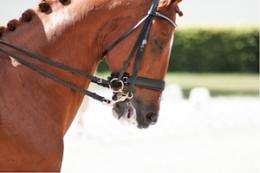Solution proposed to suffering caused by horse nosebands

(PhysOrg.com) -- Nosebands on horse bridles are being tightened so much in some equestrian competitions that horses are suffering stress, reduced blood flow in the area and ultimately even deformed nasal bones, according to Professor Paul McGreevy from the University of Sydney.
But relief may be round the corner with the introduction of a simple device, the development of which Professor McGreevy outlines in a recent publication of the Journal of Veterinary Behavior. The use of restrictive nosebands has become popular as they prevent the horse from opening its mouth which, in dressage, is regarded as a sign of resistance or lack of compliance and attracts penalties for the rider.
Another recent study by Professor McGreevy, from the University's Faculty of Veterinary Science, and UK-based colleague Dr Hayley Randle has shown that as the tightness of the noseband increases, there appears to be an elevation in horses' sensitivity to the bit, presumably because it becomes more uncomfortable. So riders may also feel that they have more control of the horse when the noseband is tighter.
"Over-tightened nosebands put so much pressure on horses' nose and mouth areas, that they cause distress and obvious injuries to the horses," said Professor McGreevy.
"These tight nosebands restrict virtually all normal jaw and tongue movements in the horses, primarily for the sake of avoiding penalties in competition.
"Nosebands designed to clamp the jaw shut very tightly - the so-called 'crank nosebands' - are only a fairly recent innovation in horse bridle design. Thirty years ago nosebands were largely aesthetic rather than functional," explained Professor McGreevy.
The International Society for Equitation Science (ISES) co-founded by Professor McGreevy, has recently made a number of recommendations for equestrian competition organisers to decrease the harmful effects of over-tight nosebands.
With the 2012 Olympic Games fast approaching and horses being the only animals to compete, Professor McGreevy is particularly keen to see the recommendations on noseband pressure implemented to protect competing horses.
"The recommendation is that competition organisers reinstate the traditional practice of leaving a two-fingers-sized gap under the noseband to demonstrate that it has not been over-tightened. If this is made an official part of competition rules, then riders will comply," said Professor McGreevy.
"A two-fingers-sized gap below the noseband allows horses to chew naturally and to express tension or seek relief from the pressure of the bit, making competition a far more comfortable experience for the horse. Allowing riders to benchmark their horses' relaxation is a principle called 'ethical equitation'."
"The practice of over-tightening nosebands to avoid penalties in competition covers up poor training at the expense of horse welfare. By instituting rules to make sure nosebands aren't tightly clamping horses' mouths shut, we will not only alleviate horse suffering, but also promote excellent training."
Professor McGreevy has developed a standard simple taper gauge that can be used by stewards at competition, to measure the gap below the noseband in a fair and objective way.
"In most equestrian disciplines, stewards check that all equipment used on horses complies with the regulations specified for that discipline, so adding this simple noseband tightness test would be quite easy for competition organizers," said Professor McGreevy.
"Adding this quick test to competition protocol would ensure that the detrimental effects of over-tightened nosebands were lessened, making a huge difference to horse welfare in these sports."
Professor McGreevy is the co-author, with Emeritus Professor Bob Boakes, of "Carrots and Sticks - the principles of animal training."
Provided by University of Sydney



















